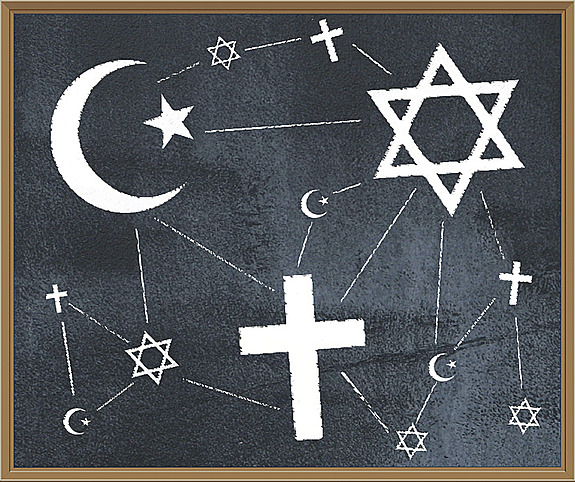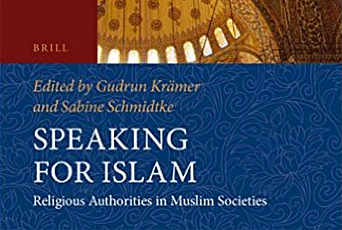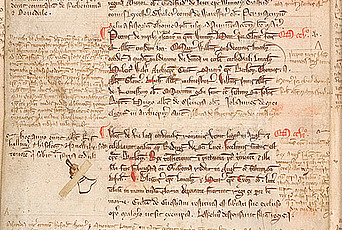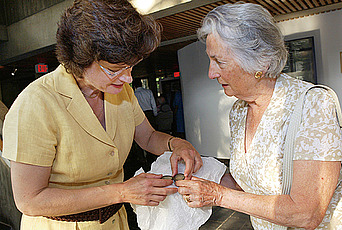In 2017, Katharina Heyden, theologian and current Director’s Visitor, founded the Interfaculty Research Cooperation on “Religious Conflicts and Coping Strategies,” with the aim of better understanding the role religion plays in social conflicts and exploring religion’s potential to both pacify and exacerbate such conflicts. The Cooperation, which she ran as Director through 2022, was a huge collaborative project involving over 40 scholars across a broad variety of fields; in addition to theology, religious studies, and history, scholars worked in areas such as law, psychology, political science, ethnology, and media sciences.
Heyden met Institute Director and Leon Levy Professor, David Nirenberg (then based at The University of Chicago), during a conference titled “Claiming History in Religious Conflicts.” At the conference, Heyden, a Full Professor for Ancient History of Christianity and Interreligious Encounters at the University of Bern, Switzerland, listened with great interest to a lecture delivered by Nirenberg on the subject of “The Historian as Theologian.” The lecture opened a fruitful interaction between the two, and their shared perspective became the impetus behind the current collaboration between the Institute for Advanced Study and the University of Bern. This collaboration, the Co-produced Religions Project, seeks to think collaboratively about the religions of Islam, Christianity, and Judaism using the concept of co-production as a methodology.
Heyden explains, “The intersections of Islam, Christianity, and Judaism are well-known, but scholars tend to treat each as largely independent from the others, at least after some initial point of origin.” The Co-produced Religions Project instead wants to highlight the interdependence of these religions—to see, in fact, that interdependence is a fundamental attribute of the three traditions. Judaism, Islam, and Christianity have formed, re-formed, and transformed over time through interacting with or thinking about one another, such that their pasts, presents, and futures cannot be examined or understood separately. Where intercultural and interreligious studies have been fruitful, they have often also been one-sided, teaching us about a specific group’s perception; instead, exploring the three traditions as a co-production captures the dynamic of the three’s constant transformation in relation to one another.
The Co-produced Religions Project currently includes 11 postdocs (4 located at IAS and 7 in Bern) and 13 senior scholars of the three religions from around the world. These collaborators work on their own research, as well as collaborate on kindred projects. Some of this work is turned into short studies for the Project’s digital archive. Open seminars and in-person conferences and workshops help in the production of co-authored papers.
Heyden dove deeper into the concept of co-production, the details of this collaboration, and what it means to think together in the humanities when she spoke to The Institute Letter this spring.
IL: What was your shared perspective with David Nirenberg that grew into this project?
KH: In our conversations, David and I discovered many kindred ways of thinking about not only the entanglement of Judaism, Christianity, and Islam, but also the relationship between critical and constructive work on religions, competing hermeneutics, history, and theology. We both think that the notion of religious co-production can be a productive way of thinking about the entangled histories of the three religions— and that such a notion could help explain the deep ambivalence in the relationship between them, as well as open more potentials for constructive thinking with an historical awareness within these religions. When creating our project, we tried to create a framework which would allow for intense thinking about the notion of religious co-production itself, while also allowing the opportunity to build up a digital archive with sources and case studies that show what kind of work the notion of co-production can actually do.
IL: How might the concept of co-production as a methodology be fruitful in research fields beyond religion?
KH: Co-production can be applied to almost everything that results from any kind of human interaction. Almost every culture, every knowledge, every society, every history is co-produced. So, we do see the notion of co-production as broadly applicable—in fact, co-production has been used recently within political science and sociology as a more normative concept to foster social integration in making laws, creating communities, etc.—but its methodology has to be adjusted and refined for any specific case or context in order to be a useful tool for academic work.
Interestingly, when we first discussed a draft of our conceptual paper in the group and elsewhere, many of our colleagues asked us to sharpen and limit the concept of co-production in order to make it a useful methodology for them to work with. Now, when I present the project and the idea of co-production to even broader interdisciplinary audiences, colleagues from many different fields can immediately see why thinking in terms of co-production can be very inspiring for them too.
IL: How does the methodology of co-production look when applied to the study of religions, and specifically within your project?
KH: Every human interaction within any dimension of the religious (artifacts, rituals, laws, symbols, stories, images of the divine, etc.) will involve some kind of co-production. In the case of Judaism, Christianity, and Islam, we encounter a more specific type of co-production. These three traditions have a common and competitive history which leads to shared and competing hermeneutics. This is heightened by the fact that they are “historical religions” (i.e., they think about revelation in terms of and connected to past events). Often, to make work on co-production manageable, we choose to focus on one specific object, or ritual, or passage, or story, or theological motif. We call these “moments” of religious co-production. Still, because so many things turn out to be relevant and interrelated in these three traditions, if experts on the three traditions in their various cultural forms look together at one such “moment,” it is almost always like opening Pandora’s box.
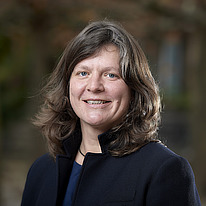
IL: You mention that intercultural and interreligious studies, while fruitful, can be one-sided. Can you think of an example from the Co-produced Religions Project that would highlight the difference?
KH: Here is an example: there has been much work done on the perceptions, images, and imaginations of Muslims and Jews as “religious others” in Christian sources, both texts and images, in the past decades. As a result, we now know much about how “othering” works in religious histories and hermeneutics. What is less examined, and therefore less understood, is what work such representation of “others” did for the self-perception, or self-creation, of those who perceived and presented the “others.” Co-production is very much about the back and forth of images and imaginations, narratives and counter-narratives, perceptions and repercussions. And it is not limited to detecting the intentions of authors we can clearly identify as either Muslim, or Jewish, or Christian (which is what both historians and theologians usually try to figure out). It is more about the dynamics and new meanings that emerge from the various interactions of historical agents. And to understand that, you need to include sources and pieces of evidence from many places and times and not limit yourself to the study of one or another clearly identifiable agent or author.
IL: How does using the concept of co-production to capture the dynamic of these three traditions’ transformations help you, as a theologian, understand the past with an eye toward the present and the future?
KH: Religious “insiders” and communities tend to think of (and represent) their traditions as traditions of developments, rather than entanglements. (Alas, the English cannot really duplicate the German pun with the words “Entwicklung,” which means development, and “Verwicklung,” which means entanglement.) This has to do with a certain ideal of “purity” in many religions. But historical research on religions teaches us that there is no such thing as pure tradition, or pure development. This is the critical potential of historical research.
But there is a constructive potential, too. If religious communities can learn to think of themselves as co-produced, they will also learn to acknowledge what they owe to each other, in the good and the bad sense of owing. Such awareness of being deeply co-produced could be cultivated within religious communities in gestures and attitudes which are grateful and responsible to the others at the same time. If we take co-production seriously, we have to admit that neither of the three traditions can understand themselves without the others, that each one was, is, and will be dependent on the others for historical reasons.
When I give sermons in Switzerland, I always try to preach with a kind of awareness that the Christian tradition has always been co-produced. This includes not only showing what Christians owe to Jews and Muslims, but also pointing to the ambivalent potentials almost every theological thought in Christianity has with regard to Judaism and Islam, which is, of course, something that preachers often would rather avoid.
IL: What does “thinking together” look like for the Co-produced Religions Project?
KH: Thinking about historical and hermeneutical co-production in and across Judaism, Christianity, and Islam almost always requires collaboration. I guess this is mainly because we are trained as we are: as experts in only one, or sometimes even two, of the traditions. In a sense, the way we are trained in academia today is still mirroring the tendency of religious traditions to treat themselves independently from each other! One might hope this will change in the future, but even then I don’t think that one single scholar can really embrace everything that is necessary to seriously examine the co-production of these three religions. The challenge starts with language skills and mere knowledge of historical archives: for antiquity and the Middle Ages, you must at least cover sources in Hebrew, Aramaic, Syriac, Greek, Arabic, and Latin. And then there is also Coptic, Ethiopic, Armenian, Georgian, Judeo-Arabic, etc. Not to forget material cultures, which are so important if we try to understand “lived religion.” For this, we need the expertise covered by archeologists and art historians. Then, in order to be able to understand such a complex phenomenon as religion, you need to combine etic and emic perspectives, i.e., inner-religious (such as theology, philosophy, and law) and outside perspectives (meaning sociology, anthropology, ethnology, and religious studies). Very few academics are trained to combine emic and etic perspectives and methodologies. So I would claim that serious academic research on the co-production of these three traditions in all their variety cannot be anything but a collaborative effort.
Sometimes, when I see scientists standing at the huge blackboards in Rubenstein Commons—where my office is located—vividly discussing equations, formulae, and other scientific problems, I find myself wondering: what would scholars in my own field, history of religions, do if they found themselves together at a blank blackboard? One could say our project on “Co-produced Religions: Judaism, Christianity, and Islam” is an attempt to gather scholars from very different disciplines and academic cultures on a blackboard. Religion is, of course, not a problem one could “resolve” like a scientific problem. But it is no less complex. And given that the three religions have proven their potential to both aggravate and pacify conflicts throughout history to this present day, it is not only a fascinating subject but also an important goal to better understand the ambivalent dynamics and potentials of religions.
The Co-produced Religions project will continue its work with a conference on “the excluded third” in June 2025, along with its open seminars, book series, collaborations and co-authored papers, and additions to the digital archive. To access their digital archive and find out more about the project, visit coproduced-religions.org.
